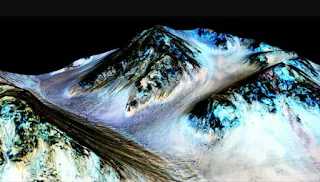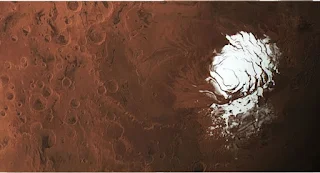Water
on Mars
Introduction
Mars
is the fourth planet from the Sun and the second smallest planet in the Solar
system after Mercury. Have you heard the big
news!?
NASA
has reported there is water on Mars. Let’s travel to the Mars now..
Using
an imaging spectrometer on NASA’s Mars Reconnaissance Orbiter(MRO), researchers
detected signatures of hydrated minerals on slopes where mysterious streaks are
seen on the Red Planet.
These
dark, narrow 100 meter-long streaks called ‘recurring slope lineae’(RSL) flowing
downhill are inferred to have been formed by contemporary flowing water.
Recently, planetary scientists detected hydrated salts on these slopes at Hale
crater, corroborating their original hypothesis that the streaks are indeed
formed by liquid water.
Another
view of ‘recurring slope lineae’ or RLSs, flowing out of a mountainside on
Mars.
Almost
all water on Mars today exists in small quantities as vapour in the atmosphere
and occasionally as low volume liquid brines in shallow Martian soil. The only
plane where water ice is visible at the surface is at the north polar ice cap.
Scientists
have also travelled deep underground into mines and found microorganisms
related to ancient species that once lived in watery environments much close to
the surface. Such migrations raise the possibility of the same thing happening
on Mars- as the water retreated, life moved deeper underground.
However,
while the find is tantalizing for astrobiologists eager to find alien life, it
is also a bit of tease. It will be decades before astronauts can visit the
surface of Mars and likely much longer before we can drill a mile beneath the
dusty surface. So we may not see any expeditions in our lifetime.
Observations
of the Red planet indicate that rivers and oceans may have been prominent
features in its early history. Billions of years ago, Mars was warm and wet
world that could have supported microbial life in small regions. But the planet
is smaller than Earth, with thinner atmosphere. Over the time, as liquid water
evaporated, more and more of it escaped into space, allowing less to fall back
to the surface of the planet.
More
than five million cubic kilometres of ice has been identified at or near to
cover the whole planet to a depth of 35 meters.
Although
there are some extremophile organisms that survive in hostile condition on
Earth, including stimulations that approximate Mars, plants and animals
generally cannot survive the ambient conditions present on the surface of Mars.
Surface gravity of Mars is 38% of Earth. Researches are going on this area.
Submitted by
Students
1st
M.Sc. Physics
- Internet
- Journal





Lucky Club Casino Site - Live and Online Gambling Games
ReplyDeleteLucky luckyclub.live Club Casino is a trusted online gambling platform powered by Microgaming. The site offers a wide range of casino games, live games,